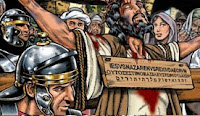 The question below comes from Bible artist Greg Owen from the U.S.
The question below comes from Bible artist Greg Owen from the U.S.What did the sign look like that was on the cross? Was it a clay tablet? Was it wood? Were the letters painted, or written in chalk? Did it hang from a rope, or was it nailed up? (weren't nails expensive, making rope or wooden peg more likely?)
Perhaps we cannot know for sure. But what is your best guess, considering Roman history and the most common ways of making signs at this time in history?
Thanks for this question Greg. When I recently illustrated the Crucifixion story, I must admit, my research was more centered on the inscription rather than on the tablet itself. In 'Bible Manners and Customs' it says:
"It was a Roman custom in cases of capital execution to put on a tablet the crime for which the condemned suffered, this tablet being placed in full view of all who witness the execution.... The tablet was sometimes carried by the condemned man himself, hung around his neck, on the way to execution.
In the official Language of the Romans it was called 'Titulus'. It was a metal plate, having black letters on a white ground."
It would make sense that this tablet was made of metal as it would have been reused from one execution to the next. In the last post we looked at how the black ink used at this time was also water soluble so each inscription could have been easily washed off with a sponge and water. How was the metal background whitened? It's possible that the same chalk mixture that was used to whiten tombs, (see 'Raising Lazarus' post), was used. This was also water soluble.
No doubt the heinous crimes recorded on these tablets were intended to incite and enrage the onlookers!
Jesus' crime "THIS IS JESUS THE KING OF THE JEWS" must have received a mixed reaction.
It would also make sense that the rope which supported the tablet around the neck of the victim, also held the tablet to the cross, hung from a wooden peg nailed into the vertical beam. Most scholars believe that only the horizontal beam of the cross was carried by the victim to the crucifixion site.
There are others who believe that these tablets were made from hardwood.
Whether you believe in relics or not, there is one relic that some experts believe to be the actual sign from above the cross. The 'TITULUS CRUCIS' was made of walnut wood! So maybe my wooden representation of the titulus, shown above, was not too far out!
Related posts:
Crucifixion (part 1)
Crucifixion (part 2)